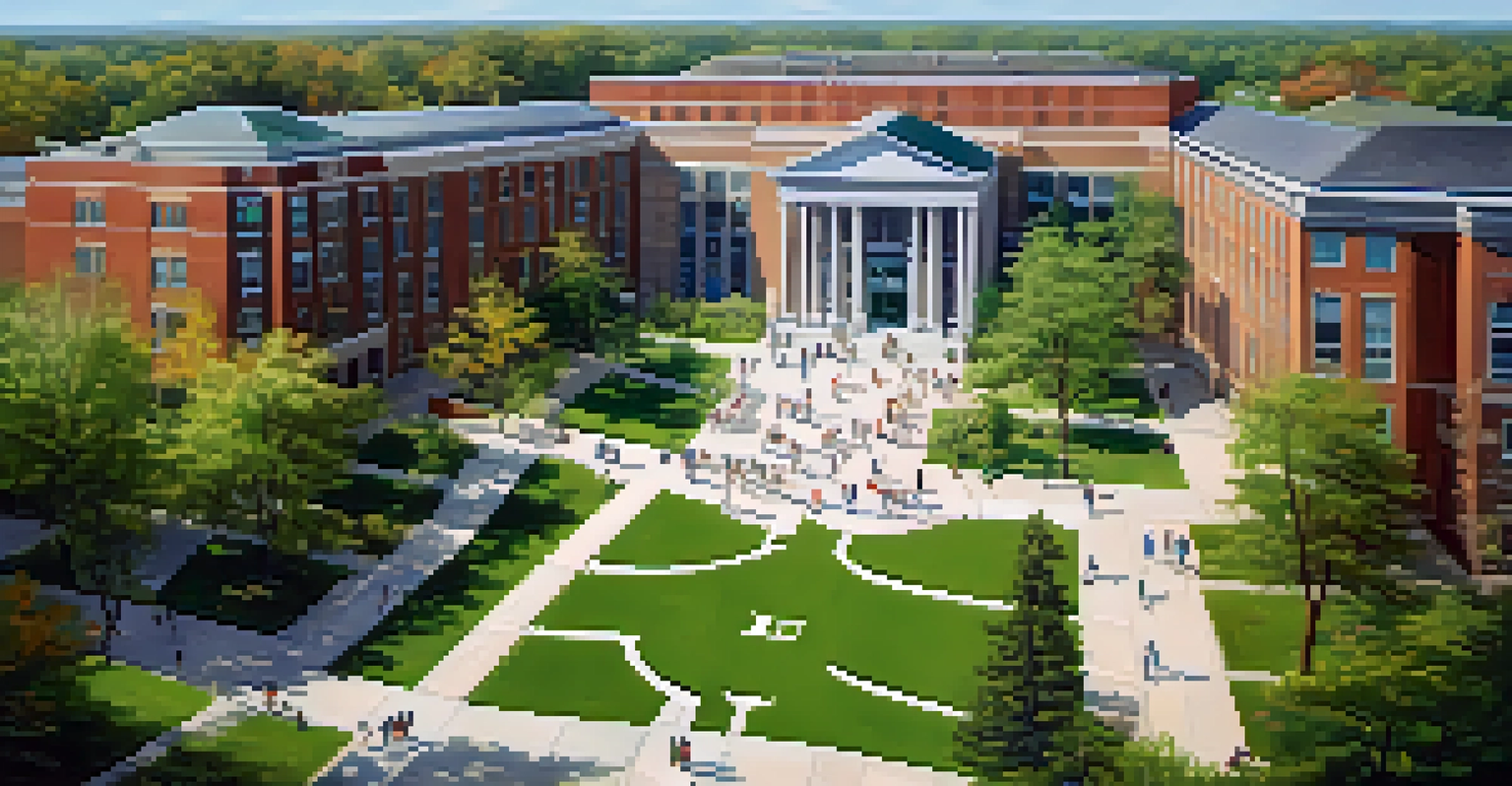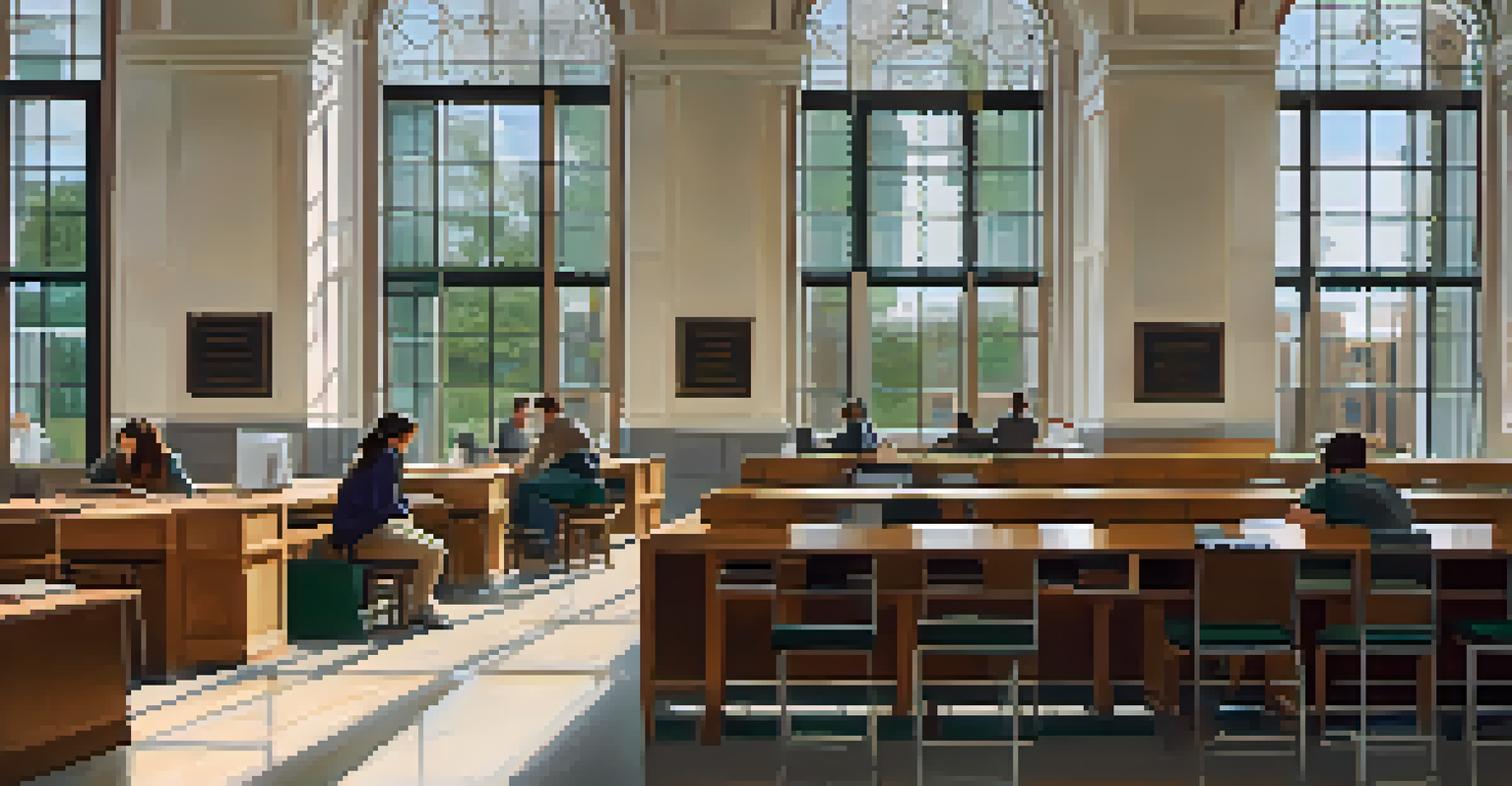The Evolution of Michigan State University's Campus Facilities

Early Beginnings: A Look at MSU's Foundational Structures
Michigan State University, established in 1855, began with simple structures to accommodate its original agricultural focus. The earliest buildings, like College Hall, were functional, serving as classrooms and laboratories for budding scholars. As the institution evolved, these foundational facilities laid the groundwork for a more comprehensive educational experience.
Education is not the filling of a pail, but the lighting of a fire.
In those early days, the campus was primarily focused on agricultural education, which shaped the design and purpose of its facilities. For instance, the early barns and greenhouses reflected a commitment to hands-on learning and agricultural research. The emphasis on practicality in these designs set the tone for future developments on campus.
These initial buildings were not just educational spaces; they represented a vision for broader growth. As the student population grew and academic disciplines expanded, the need for more sophisticated facilities became apparent, prompting ongoing renovations and new constructions.
The Expansion Era: Building for Growth and Diversity
As the 20th century approached, Michigan State University experienced significant growth, leading to the construction of larger, more diverse facilities. This era saw the introduction of iconic buildings such as the Library and the Student Union, which catered to the expanding needs of students and faculty alike. These structures not only provided additional space but also fostered a sense of community on campus.

The architectural styles began to reflect a blend of functionality and aesthetics, with a focus on creating welcoming environments. For example, the Library was designed to be a hub of knowledge and interaction, complete with reading rooms and study spaces. This shift towards more inclusive and well-designed facilities marked a significant step in the university's evolution.
MSU's Commitment to Sustainability
Michigan State University integrates eco-friendly designs and green buildings into its campus to promote environmental responsibility.
With an increasing number of students from different backgrounds, the campus aimed to create spaces that were not only functional but also reflective of a diverse community. This led to the development of cultural centers and student lounges, emphasizing the importance of inclusivity in the university's mission.
Modernization: Embracing Technology and Sustainability
The late 20th and early 21st centuries brought a wave of modernization to Michigan State University's campus facilities. With the rise of technology, the university began to integrate smart classrooms and advanced research labs into its infrastructure. This focus on innovation ensured that students were equipped with the tools they needed to thrive in a rapidly evolving world.
The future belongs to those who believe in the beauty of their dreams.
Sustainability also became a key consideration during this modern era, with the construction of green buildings that minimized environmental impact. Facilities like the new STEM building were designed with energy efficiency in mind, showcasing MSU's commitment to responsible stewardship of resources. These developments not only enhanced the learning environment but also positioned MSU as a leader in sustainable practices.
The blend of technology and sustainability in campus facilities reflected a broader trend in higher education, where institutions seek to prepare students for future challenges. By creating spaces that foster innovation and environmental responsibility, MSU continues to evolve in alignment with contemporary societal needs.
Campus Life: Creating Spaces for Community and Engagement
At the heart of Michigan State University's campus evolution is the focus on enhancing student life. Facilities like the MSU Union and various residence halls have been designed to promote interaction and engagement among students. These spaces are vital for building a sense of community, where friendships are formed and experiences are shared.
The renovation of existing facilities and the construction of new ones have prioritized social spaces that encourage collaboration. Recreational centers and student lounges have become essential in supporting student well-being and fostering a vibrant campus culture. This emphasis on community spaces is a testament to MSU's commitment to holistic education.
Focus on Community and Engagement
The university prioritizes social spaces and facilities that foster interaction and collaboration among students.
Moreover, the university recognizes the importance of extracurricular activities in shaping student experiences. Facilities that host events, performances, and gatherings provide opportunities for students to explore their interests outside of academics, further enriching their time at MSU.
Historical Preservation: Balancing Tradition and Progress
As Michigan State University continues to grow, preserving its historical buildings remains a priority. Structures like Beaumont Tower not only serve as landmarks but also embody the university's rich history and traditions. The careful preservation of these sites allows current and future generations to connect with the past while embracing modern advancements.
Balancing modernization with historical preservation can be challenging, yet MSU has navigated this journey thoughtfully. Renovations often aim to enhance the functionality of older buildings while respecting their architectural integrity. This approach ensures that the university's heritage is honored, even as it adapts to contemporary needs.
By integrating historical elements into modern designs, Michigan State University creates a unique campus atmosphere that celebrates its legacy. This blend of old and new enriches the academic environment, reminding students of the rich history that shapes their educational experience.
Future Directions: Innovations on the Horizon
Looking ahead, Michigan State University is poised for exciting developments in campus facilities. Plans for future constructions include state-of-the-art research centers and collaborative spaces that prioritize interdisciplinary learning. These innovations aim to keep pace with the evolving educational landscape and the needs of a diverse student body.
The university is also exploring the integration of more outdoor spaces, recognizing the importance of nature in the learning environment. Green spaces, gardens, and outdoor study areas are being designed to enhance student well-being and foster a connection to the environment. This focus on outdoor facilities reflects a growing awareness of holistic education.
Balancing Tradition with Modernization
MSU successfully preserves its historical buildings while enhancing functionality to meet contemporary educational needs.
As MSU continues to evolve, the commitment to creating inclusive, innovative, and sustainable facilities will remain at the forefront. The future of campus facilities promises to be dynamic, ensuring that Michigan State University remains a leader in higher education.
Conclusion: The Ongoing Journey of Campus Development
The evolution of Michigan State University's campus facilities is a testament to its commitment to excellence in education. From humble beginnings to modern innovations, each phase of development has been driven by the needs and aspirations of its community. The journey is ongoing, with each new facility contributing to the rich tapestry of the university's history.
As the landscape of higher education continues to change, MSU remains dedicated to providing an enriching environment for its students. By prioritizing community, sustainability, and innovation, the university is well-equipped to face the challenges of the future. This ongoing evolution reflects a broader commitment to nurturing a vibrant academic atmosphere.

In celebrating its past while embracing the future, Michigan State University exemplifies how a campus can grow and adapt. Each facility is not just a building; it’s a part of a living, breathing community that fosters learning, engagement, and growth.